It’s inevitable. A rotating orbital space station open to tourists is inevitable. The only questions are how soon, at what price and what comfort, and what will be the first company to make it happen.
I’ll present to you below the company that has laid out the clearest plans to get there to date. Their vision is bold to say the least, it’s simply the most ambitious yet inevitable startup idea I’ve seen in a long time!
Please meet the Von Braun Station below, a rotating station to be built in Earth orbit, that is planned to have a total population of 400 people, including over 100 crew. Construction is supposed to start in 2025 and be over by 2027! The station is of course named after Wernher von Braun, the German and later American aerospace engineer and space architect. Wernher von Braun led the development of the Nazi-Germany V2 rockets, then later served as director of the newly formed Marshall Space Flight Center and as the chief architect of the Saturn V super heavy-lift launch vehicle that propelled the Apollo spacecraft to the Moon.
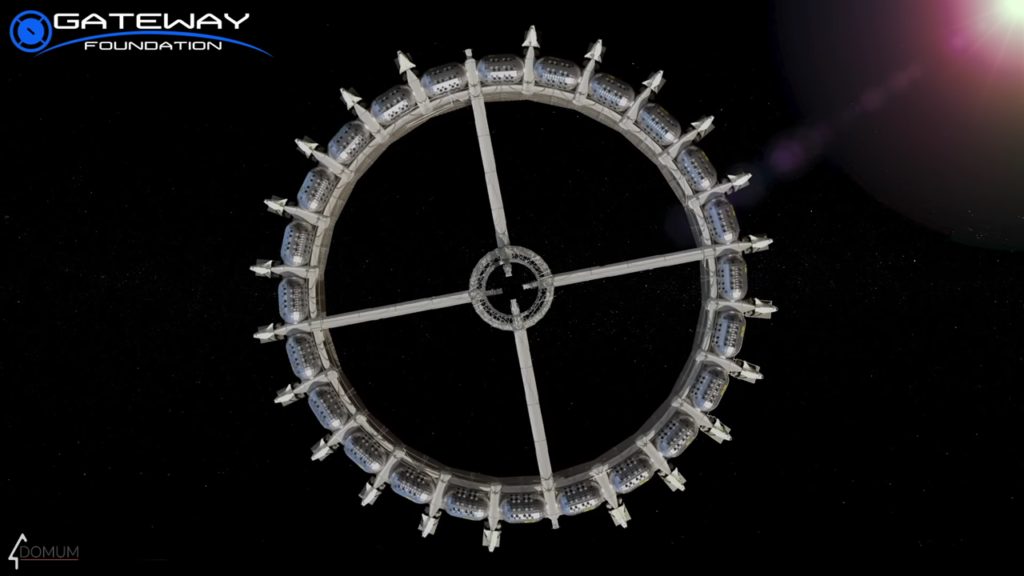
The Von Braun Station will be built by the Gateway Foundation, an organization that has just incorporated a subsidiary company called Orbital Assembly as the first step. The ultimate step is even more ambitious : build the Gateway, a structure able to house over 1,400 people in orbit, but let’s leave that last part aside for now.
The venture is led by John Blincow, who worked as an airline pilot for 24 years, and has as its Chief Architect Dr. Thomas Spilker who worked for more than 20 years as both a scientist and engineer at the Jet Propulsion Laboratory, in particular on NASA’s Voyager, Cassini, and Genesis missions, and is a Co-Investigator for the MIRO instrument on ESA’s Rosetta mission.
Let’s look at the scale of the Von Braun Station, compared to the International Space Station.
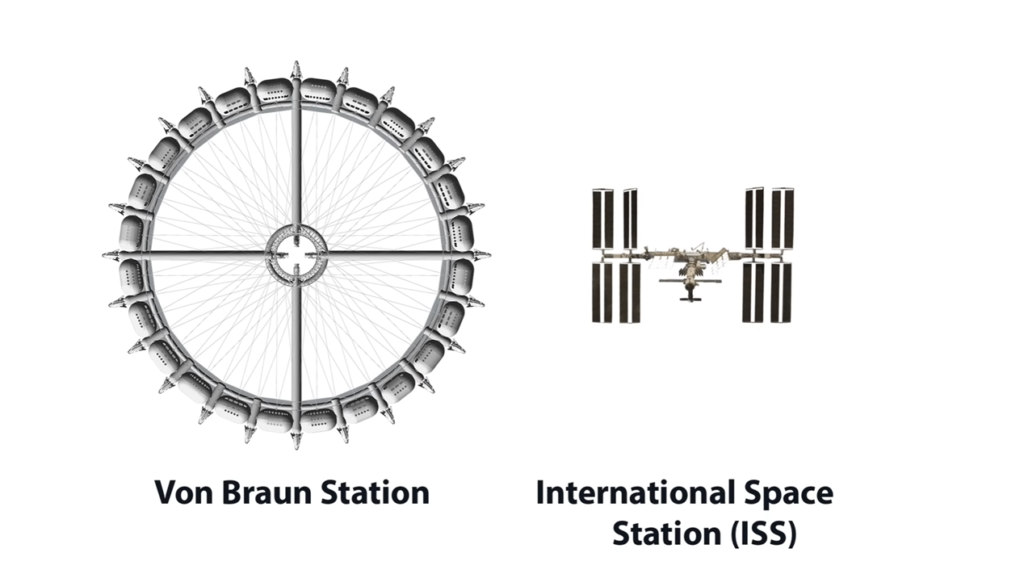
The Von Braun Station is composed of 24 cylindrical modules, each one is 20-meter long and has a diameter of 12 meters. Each module offers a total of 500m2 of habitable surface spread over 3 floors, so that’s a total of 12,000m2 for the 24 modules. Total volume of these 24 modules will amount to 2130m3. That’s 2,3 times the pressurized volume of the the International Space Station that stands at 915m3 (and is 109-meter wide and 51-meter long). The team says it will take 2 years to build the Von Braun Station (it took 12 years to assemble the ISS.)
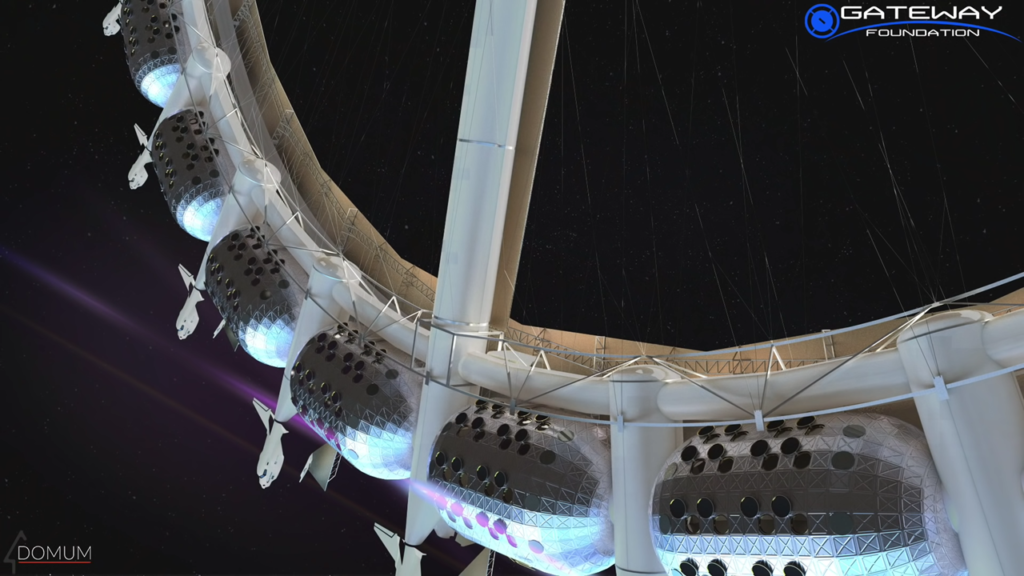
As you can see above and on the other illustrations, so as not to recreate the Titanic, each module will have quick access to an Emergency Earth Return Vehicle, for now they’re planning to use the Sierra Nevada Dream Chaser, 44 of them in total. The human-rated version of the Dream Chaser designed for Earth Return can carry up to 10 people and is able to return from space by gliding (typically experiencing less than 1.5 g on re-entry) and landing on any airport runway that handles commercial air traffic. As of August 2019, the first unmanned ISS flight of the Dream Chaser is planned for 2021. So there will be a way for up to 440 people to escape back to Earth by default using Dream Chasers. Possibly more if they ensure some larger ship always stays docked to one of the 2 ports at the center of the station.
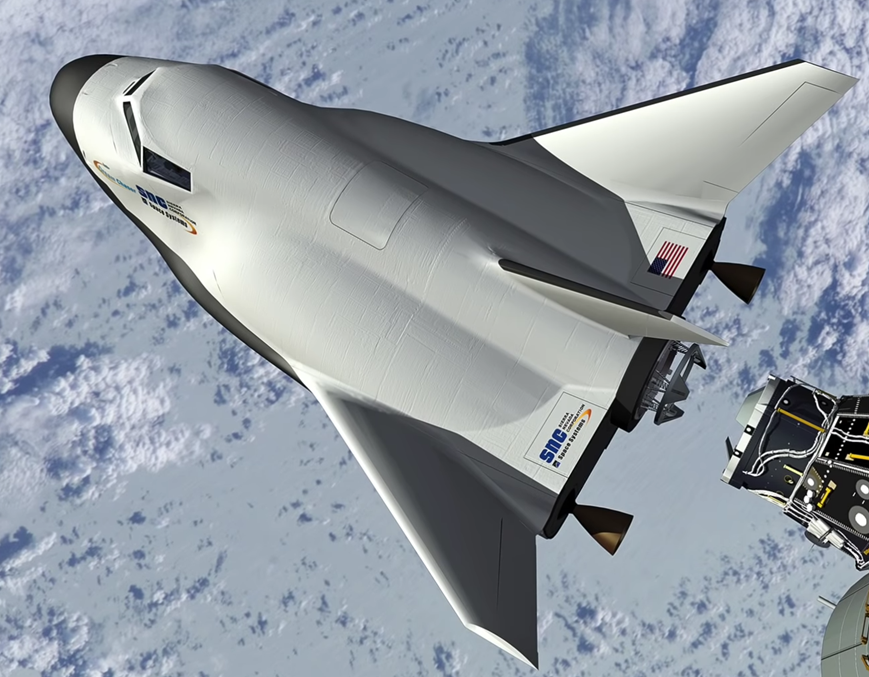
Government agencies along with companies will be able to “rent” modules and each one will be independent, so the station will function like a small community or business park, drawing on common resources while maintaining privacy and security. Energy will come from solar panels. The station will be placed in an orbital path such that one side of it will always face the sun no matter what, that side will be entirely covered with solar panels as you can see below, which will provide all the energy needed to power the station.
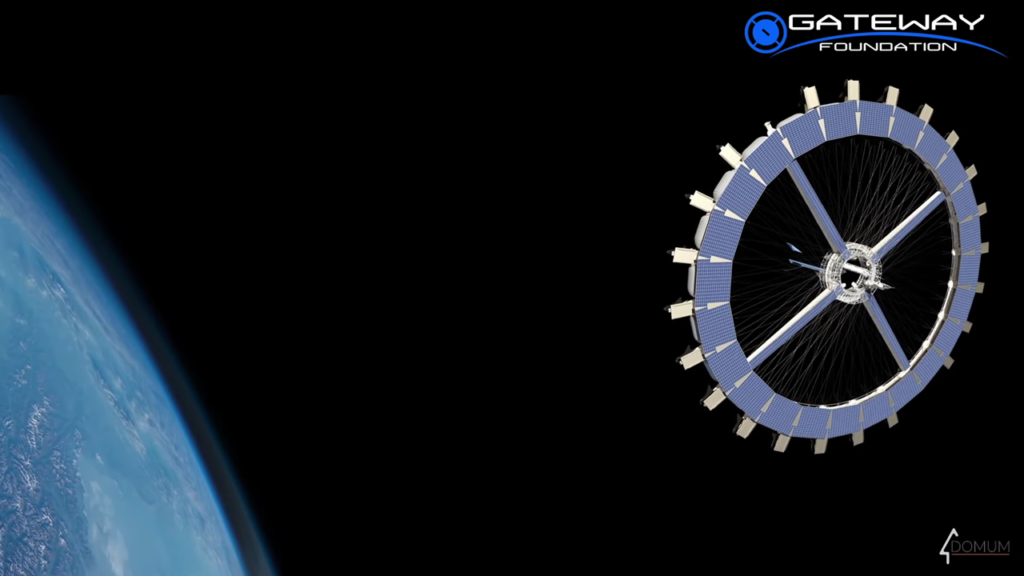
Given the 190-meter diameter of the station, it will only need to be spun gently to create artificial gravity. At first, the Von Braun Station will have lunar gravity, but if experience shows people are not comfortable enough, it can be spun faster to increase gravity, using small engines placed at each extremity of one of 2 axis, as seen below.
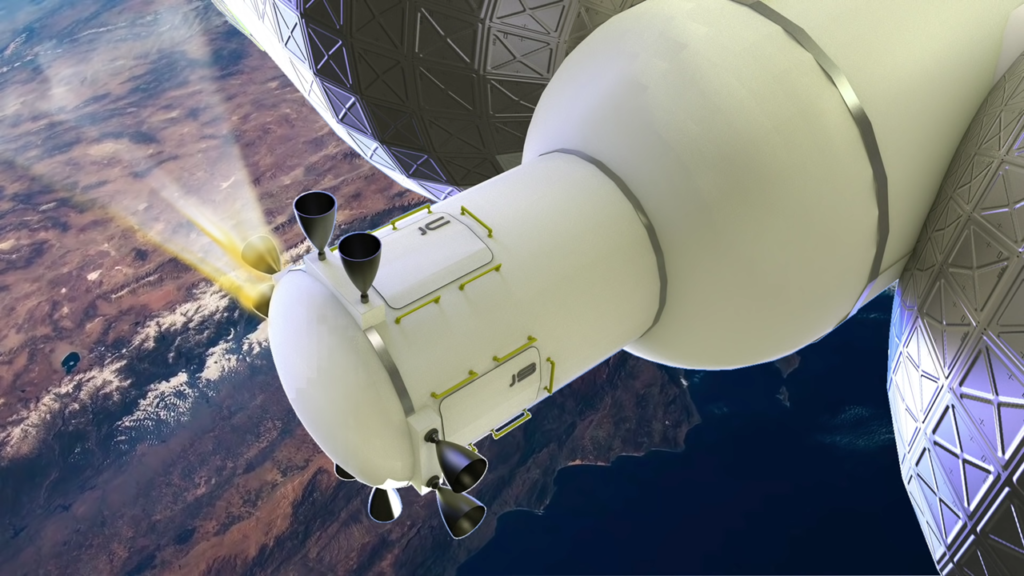
Rotating the station to produce artificial gravity is deemed key to its success, as experience on the ISS has shown that humans cannot live healthily for long in microgravity. Scott Kelly’s book Endurance : A Year in Space, A Lifetime of Discovery shows the toll his time in microgravity took on him. Beyond health concerns, it will simply be more comfortable for tourists to enjoy at least some level of gravity, especially for taking a shower, going to the toilets, eating and sleeping. In comparison, a stay at the cramped ISS looks like a camping trip. But it’s not to say that people won’t be able to enjoy microgravity : a 25th module could be added to that effect near the center of the station.
In terms of shielding against solar flares and cosmic rays, nothing needs to be invented from scratch, no revolution required given where the Von Braun Station will sit in space, still largely protected by the Earth’s magnetic field. So it will reuse and build upon all the technology developed for the ISS which, contrary to what many say, will have been priceless in furthering our understanding of many of the challenges of living in space. The Von Braun Station will owe a lot to the science conducted on the ISS, it simply wouldn’t be possible that soon if the ISS hadn’t existed.
Incoming spaceships will dock on either side of the center of the station, as seen below with a SpaceX Starship.
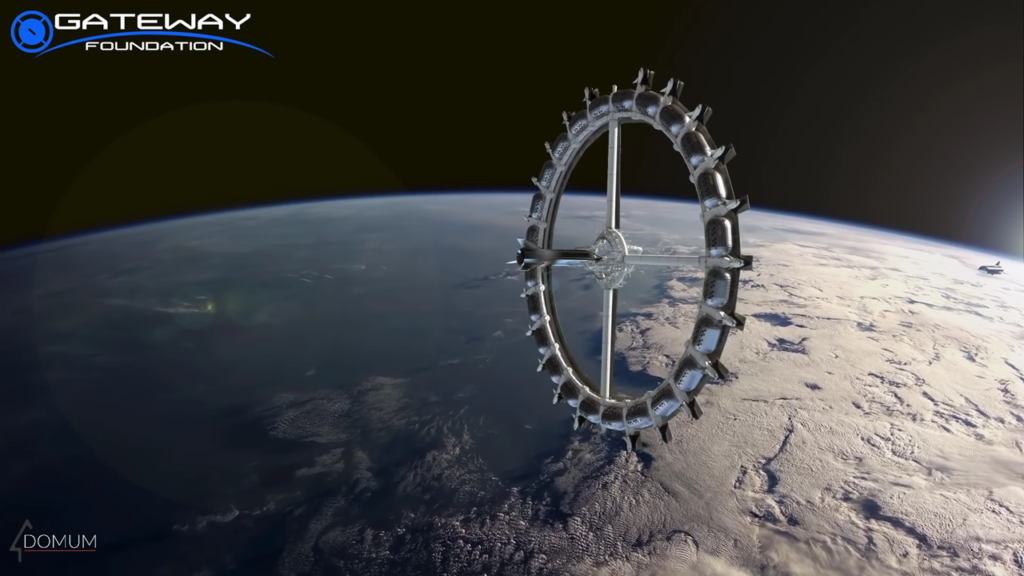
The center will be “de-spun” to make the manoeuvre easy. So think of the station as rotating around the inner docking part which will stay static when ships arrive or depart.

Each module will have 3 floors, with a total of 500m2 as said earlier, see below.
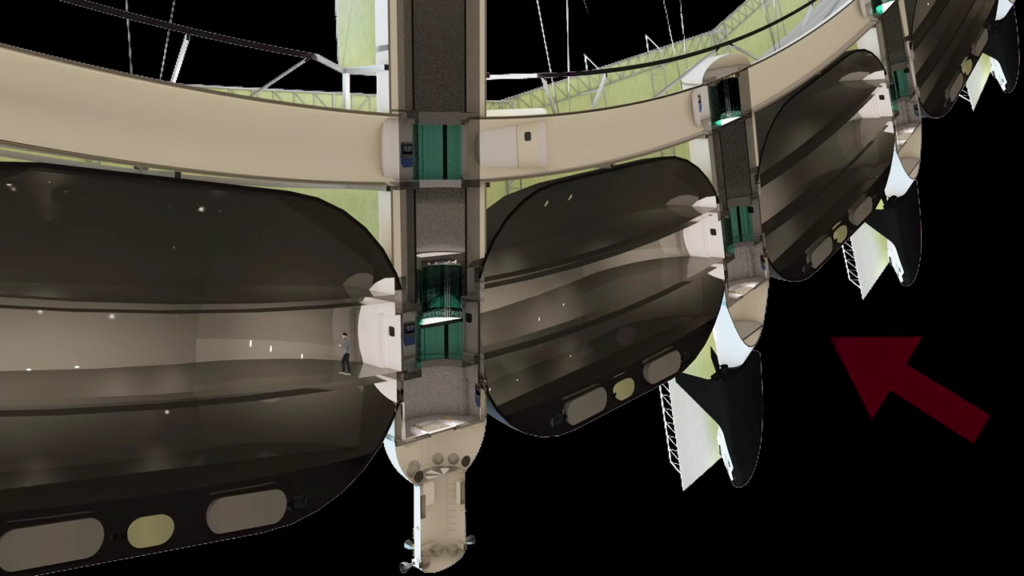
In case of depressurization of a module, people will be able to hide in the showers cabins of the rooms that will have airlocks, or escape in pressurized bubbles accessible in the corridor running all along the ring and above the modules. Out of the 24 modules, one will serve as kitchen restaurant bar (KRB) where the best food from all around the world will be served, and another one will be a gymnasium & auditorium, the GA module, where for instance people will be able to play basketball in lunar gravity – how cool would that be!
Now the rooms ! At least 12 modules will be dedicated to hotel rooms and suits.
There will be 126m2 luxury suits and 62m2 luxury rooms, see below. They will respectively set you back $5 million and $3 million for a 3 and a half-day stay. Last, there will also be 30m2 room (below) priced at “only” $2 million for a same 3.5-day stay, what a deal!
Now, lets work out some numbers.
John Blincow said on The Space Show that the Von Braun Station’s total cost would be around half of that of the ISS, which was of $150 billion. So the total cost for designing and building the pieces, launching them in orbit, assembling them, plus designing and making the tools needed in the process, all of that amounts to $75 billion. He says it will take 40 launches of the SpaceX Starship to send all the pieces up there, at an estimated $40 million per launch, that’s $1,6 billion “only” for launch costs. It would have cost 33 times more, around $50 billion, with traditional launch operators.
Just as a matter of comparison, the iconic Marina Bay Sands casino hotel in Singapore was built in 5 years at the cost $8 billion, it has 2,500 rooms, so can welcome at least 5,000 people. And the largest ever cruise ship, the Symphony of the Sea, started operations in 2018, it can carry 5,500 passengers, it took 3 years and $1.35 billion to build.
John Blincow said that while at some point they have some hope to get funded thanks to some kind of lottery system, by default he’ll turn to investors to get the money needed to fund that outstanding project, to say the least.
To put this in perspective, the 3 American startups that have raised the most money ever in US history are Juul ($14.1B), Uber ($13.7B) and WeWork ($8.4B), so John Blincow simply ambitions to raise twice of what these 3 have raised together. Construction is supposed to start in 2025, but all the tools necessary to build the pieces and assemble them in orbit have also to be designed and manufactured, so a lot of the money would need to be raised even before 2025, leaving only a few years ahead of us to get that done. They should probably get in touch with SoftBank which just launched a new $108 Billion Vision Fund, though to invest in AI by default, so they’d have to be creative when pitching, but maybe the required assembly space bots can make use of AI.
Perhaps an alternative road to financing is to presell tickets ?
They say they want to have 100 tourists visiting the Von Braun Station per week (2 batches of 50 per week, 3.5 day each I assume). With 2 people per room and, say, $2.5 million per stay for 2, at full occupancy, that amounts to 50* $2.5 million per week, that is $125 million per week and $6.5 billion per year. (As they say the station can have a population of 400 including 100 staff, there would be room for 300 tourists at any given point in time, much more than the 50 assumed above, but for our present calculations, let’s stick to 50 at the same time, and 100 per week.)
They say there will be a staff of 100 on board the station, let’s consider they get $100,000 a year in salary on average, that’s $10 million per year in total, let’s multiply that by 50 to be safe to get a sense of the eventual yearly operational costs of the station, including staff on Earth and other expenses, that amounts to $500 million per year.
So at full occupancy, we could have $6.5 billion in revenues minus expenses of $500 million, that is roughly $ 6 billion of profits per year. Here we are assuming that tourists have to pay SpaceX or Blue Origin for instance on top of everything for the cost of going to space.
So over its first 15 years of operation, at full occupancy again, the Von Braun Station could possibly generate $90 billion in profits, enough to pay back the initial $75 billion in investment and bring some nice dividends to shareholders… at least on paper based on the above rough assumptions which are probably off to some extent.
By 2030 their goal is to have two stations. So the pure design cost of the station and of the tools and equipment necessary to build it will be amortized in part over that second station as well, provided again it can achieve full occupancy.
Now let’s see if that full occupancy for one or even 2 stations for long enough is credible.
One hundred tourists per week mean 5,000 tourists per year. According to Wikipedia, in 2013 there were 200,000 people with at least $30 million in wealth (with 70,000 in the US and 16,500 in China for the top 2 countries). These people could certainly pay for a once-in-a-lifetime trip to the Von Braun Station. Not all of them would, but at the same time many of them would pay for some of their relatives and friends, they definitely wouldn’t go alone ! It’s obvious that space will exert quite a pull on people, especially on those that will have the means to get there, even more so in the era of social media. People will soon be clearly divided in two groups, those that have been to space, and those haven’t (yet). So all in all 200,000 seems reasonable as a target market for the prices listed above. At 5,000 tourists per year, that means 40 years of business for one Von Braun Station, and $240 billion in profits. So it doesn’t seem utterly unrealistic to imagine that they could use ticket presales to fund the development and construction of the station!
Final thoughts
So is it crazy ? Yes! Too good to be true ? Possibly. But even more important, is it inevitable ? Again, resounding yes ! Launch costs are plummeting, the required technology to build and assemble the pieces is not out of this world, and the lure of space on people is real, so it’s bound to happen one way or another, sooner than we think. It’s just too big an opportunity, too big a business opportunity.
So my last question is, which organization will pull this off ?
Why not the Gateway Foundation after all? To this day no other as clear-cut plans and designs have been shared by any other company. And above all they have a solid team, it’s particularly reassuring to see that their Chief Architect Tom Spilker has worked for more than 20 years as both a scientist and engineer at the Jet Propulsion Laboratory.
Anyway, we have to recognize the boldness and the vision. With SpaceX’s Starship, it’s the most fascinating space project I’ve seen in a long time that still looks like it’s within reach, we’re not talking about a Mars city for God’s sake. They deserve our attention and encouragement!
For what it’s worth, I’ve joined their Lifetime Crew membership, that will grant me some interesting privileges down the road if and when they make it happen, with chances to go to space on the cheap. As they have started revealing tangible details about their plans only very recently, they haven’t had so much attention until now, and I’m lucky to be part of the first 1,000 crew members that will have the most privileges, but there are possibly still room left within that first circle as I did it only 2 weeks back, and they also have other larger preferred circles at 10k and 100k. Given the opportunity to be part of such a fascinating project, I didn’t want to be out as for me, and took my chance to be there early, now we’ll see where it goes! In any case, kudos to the Gateway Foundation for making us dream with such formidable designs for now.
Last but not least, I told you earlier that their ultimate goal is to build the Gateway, a gigantic spaceport that can host 1,400 people, here it is below, at scale compared to the ISS and the Von Braun Station. It will have living quarters layered at 3 levels, with respectively lunar, Mars and Earth gravity, but that’s another story!
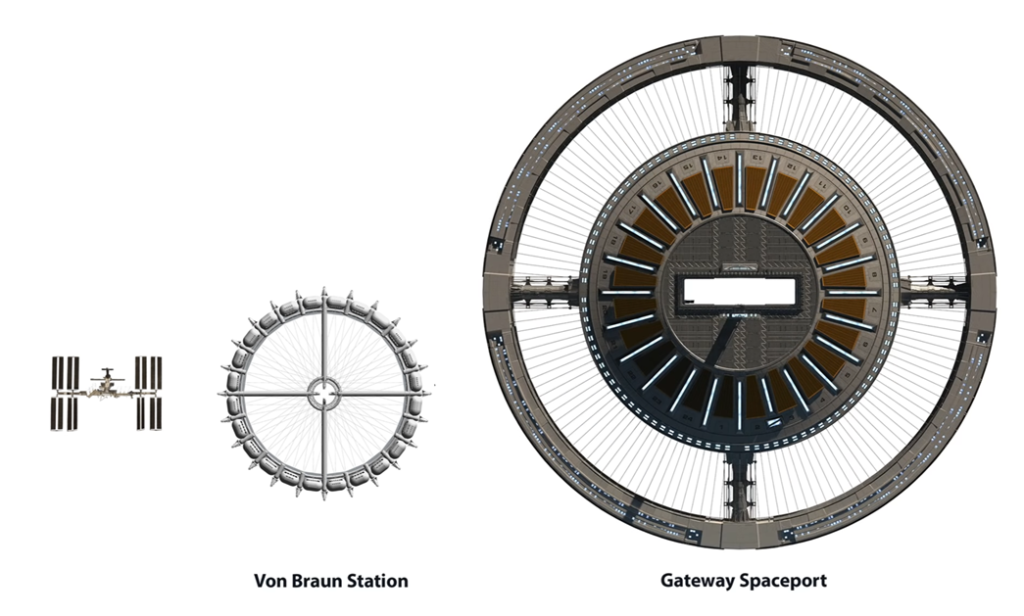
Sources :
- The Von Braun Rotating Space Station video on Youtube and other videos from the Gateway Foundation Youtube video channel
- Interview of Tim Alatorre, Senior Design Architect, Chief Von Braun CG Design Engineer, on www.dezeen.com (August 2019)
- John Blincow on Doctor Livingston’s Space Show (October 2019)

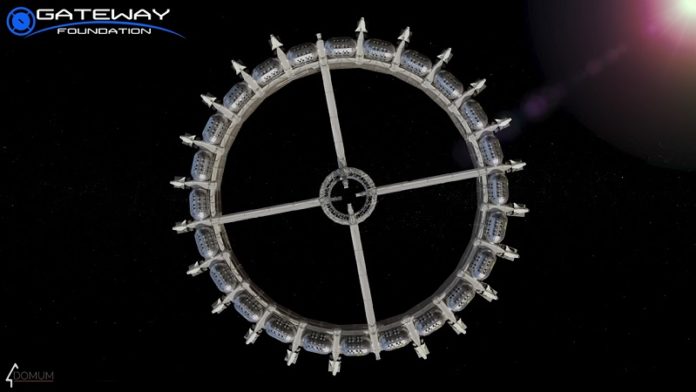



I can think of another company who had a “solid team”. Remember MarsOne?
“To this day no other as clear-cut plans and designs have been shared by any other company”.
They haven’t shared a “clear-cut” plan or a “design”.
They shared a sketch. And there are PLENTY of companies who have shared sketches.
What a deal. Let’s just take my life’s savings real quick, and… oh wait never mind. I might be able to buy a closet for a night in a few years.